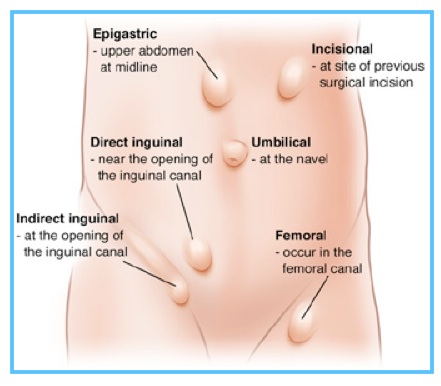Lumps, bumps, and bulges in the groin are common in children and may be due to a hernia, hydrocele, or testicle that did not make it all the way into the scrotum.
What is a hernia?
A hernia is an opening or weakness in the muscles through which an abdominal organ bulges or protudes. This opening may be congenital (a normal opening that you were born with) or acquired (an abnormal opening caused by previous surgery or prolonged coughing or straining). This is the difference between pediatric and adult hernias. Pediatric hernias usually occur through normal openings in the groin muscles whereas adult hernias usually occur due to a weakness in the muscles.
If the opening is normal, then why don’t we all have hernias? Well, this requires a longer explanation. Our body is made up of layers of muscles. These muscles surround our stomach or abdominal organs like our liver, spleen, and intestines. The innermost layer of these muscles is a lining, a “Glad bag” if you, that makes a lubricating fluid allowing organs to move within the bag without pain or irritation. In most people, this “Glad bag” stays within the muscles of the abdomen. But in some, it finds its way into these normal muscle openings and bulges through them, causing a hernia. The medical term for this “Glad bag” is the peritoneum and when it protudes through an opening in the groin, it is called it the processus vaginalis.
Three most common locations in children are groin (inguinal), belly button (or umbilical), and femoral (upper leg).
Hernias are one of the most common surgical diseases and named by either their location or cause. The three most common locations are groin (inguinal), belly button (or umbilical), and femoral (ie, next to the femoral vessels, the vessels going to the leg). Groin hernias occur in up to 5% of full term and 30% of preterm children. Umbilical hernias are much more common. Hernias are associated with other diseases such as undescended testicles, cystic fibrosis, conditions that increases the amount of fluid in the abdomen (liver or kidney diseases, and operations that put fluid in the abdomen), certain muscle or tissues disorders (mucopolysaccharidoses or connective tissue disorders), and children born with an open spine (meningomyelocele).
Most hernias are painless, found by a parent during a bath or by the physician during a routine physical examination. If the bulge cannot be seen during the clinic visit, your doctor may ask your child cough or scream. This is done to try and push something from the stomach or abdomen, through the muscle opening and into the “Glad bag”.
Hernia diagnosis in children
A hernia is diagnosed by physical examination. But, many times the hernia cannot be seen during the clinic visit. When this happens, the surgeon has several options; proceed with the operation based on the history and the pediatricians exam findings, repeat clinic visits until the hernia can be seen, or have the family take a picture of the bulge. The diagnosis does not require any X-ray studies.
Unlike hydroceles and undescended testicles, hernias should be fixed when they are found. The reason is that a piece of bowel may get caught in the hernia sack causing a blockage in the bowel (incarcerated or strangulated hernia). Importantly, the risk of incarceration is inversely related to age; the younger you are the higher the risk.
Hernia surgery in children
The operation is done under a general anesthetic, either through a small incision over hernia (most commonly) or laparoscopically (through three small incisions). If your child has a hernia, he/she has a small risk of having another one on the other side. Therefore, at operation, the surgeon may use a laparoscope to look at the other side; this can be done through the hernia incision. In the past, some pediatric surgeons would routinely “explore” the opposite side, looking for this second hernia. This is no longer recommended.
As with anything in life, operations come with risks. The risks of hernia surgery are small and include scar, bleeding, infection, damage to the vas (the tube carrying the sperm; <1%), damage to testicular vessels (<1%), and recurrence (<1%).
Outpatient surgery for hernia repair
Most procedures on healthy infants and children are done as an outpatient. Your child will be discharge when he/she is comfortable, able to take liquids and has normal vital signs. Children who do not meet this criteria will be admitted overnight. Also, all premature (<36 weeks gestation) who are not > 65 weeks post-conceptions (ie gestational age + chronological age) should be observed in the hospital overnight due to the risk of apnea (decreased breathing) and bradycardia (slow heart rate).

